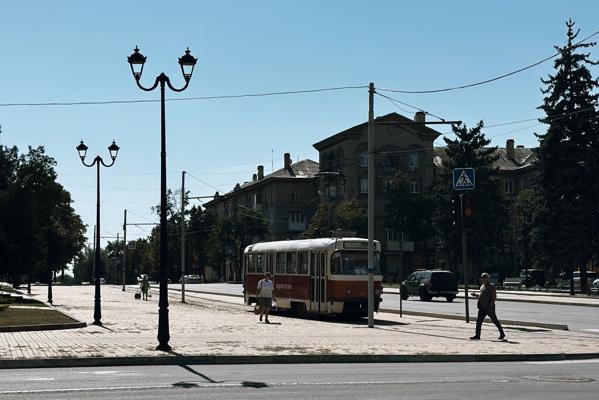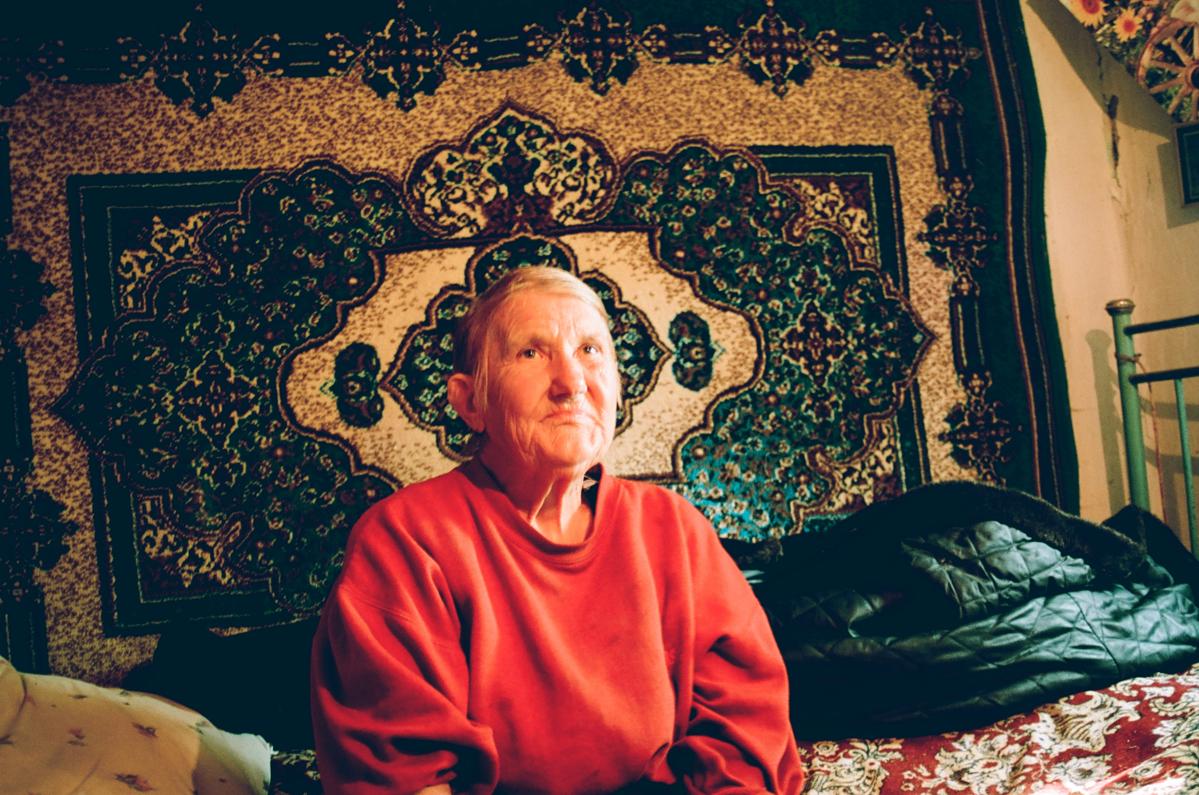
Druzhkivka. The City of Destroyed Memories
Due to the approaching front line and constant shelling, a mandatory evacuation of families with children has already been announced in Druzhkivka. The city is emptying, but life continues here
Read moreIn autumn, the East still holds on to its warmth so intensely, so you can wear a T-shirt. Trams move slowly down the deserted streets. The wind rustles through empty window frames

Kramatorsk. October 2023
In autumn, the East still holds on to its warmth so intensely, so you can wear a T-shirt. Trams move slowly down the deserted streets of the residential neighborhood. The wind rustles through empty window frames. Locals are either tending to their gardens or rebuilding homes. Among a patch of pink flowers, the gray hair of an elderly woman peeks through. The sound of tools echoes from a nearby porch.
I walk over to greet her and explain I’m a journalist looking for people to speak with for my next report. At once, the woman grabs my hand and leads me through the garden gate.
Liubov Prokofiivna has lived here for seventy years—since she was a baby, as she puts it, “cradled in Donbas.” Her husband passed away a few years ago, and now she handles everything around the house on her own. After the shelling, her hands and legs began to tremble. Now, as she walks around the yard, she jokes that she’s dancing a kind of eastern boogie-woogie.
Her house was hit by a Russian shell over the summer. The blast blew out the windows, destroyed the chimney, and caused the ceiling to collapse. In the bedroom, plaster lies in heaps on the floor. Shards of glass still glint here and there.
“I was outside, just coming back home,” she recalls. “Standing right in the entryway, when the shock wave threw me to the garden. Somehow, I managed to call my daughter. She came and helped me get back on my feet. But my hands still tremble—the doctor says it’s because of the stress. I even kept one of the fragments that hit. But I forgot where I put it.”

The volunteers repairing her roof and windows—Bohdan and Mykola—are local guys who started helping their community as soon as Russia launched the full-scale invasion of Ukraine. They’re not part of any official organization. Usually, they just get to know where help is needed. Or the "word-of-mouth radio" works. They scrounge up materials and tools where they can, and so far, they’ve rebuilt over 80 homes.
Most of the people they help are elderly—those who, for the most part, still live here. Bohdan and Mykola also evacuate civilians from active combat zones and deliver humanitarian aid to de-occupied villages. They’re always busy.


Liubov Prokofiivna and I finish a watery cup of coffee—she made two full mugs just for me—and we head into the yard. An old apple tree stands nearby, one she planted long ago with her husband. Because of her small stature, she can only reach the apples that fall to the ground. The bowl beneath the tree is full of ripe, bright red fruit. They may not look perfect, but they taste like the best apples on Earth. I eat three and pocket two more.

“I used to tend the garden, dig up the beds, work a little,” she says. “Now what can I tell you... I’m sick, I’m old. But I still get around on my own,” she adds with a wink. “I take it day by day now, and my daughter helps out, looks after me.”
At the end of our conversation, she tells me about her grandson, who moved with his mother to a safer place. She fondly recalls playing with him on the porch in the summer and says she’s waiting for the war to end so she can see him again. She says little else about her family, says it’s personal.
I squeeze her small hand and step through the gate, past a bloom of vibrant violet flowers. The old woman settles onto a stool and watches as her house is being slowly stitched back together—like with plasticine—after the missile strike.

August 2024
It’s now been ten months since I visited Liubov Prokofiivna. Much has changed on the front line. Most notably, Russian forces occupied Avdiivka—a city that Ukrainian troops had defended for ten years, since the beginning of the war. The volunteers who rebuilt Liubov’s home continued evacuating people until it was possible.
After the occupation of Avdiivka, Mykola joined the Armed Forces of Ukraine (on January 3, 2025, he went missing in the fighting in Chasiv Yar). His teammate, Bohdan, still helps evacuate people from front-line towns and villages.
Just a few days ago, Bohdan visited Liubov again. She, as always, was busy in the yard, gathering the August harvest. She visits neighbors and goes to the local market. The nervous tremors have mostly subsided. Only under stress do her hands begin to shake again. Working with her hands, she says, is the best medicine there is.
She made Bohdan a cup of coffee and proudly showed him the ceiling they had fixed before winter. And just as firmly as before, she said her goodbye:
“I’m not leaving. This is my home.”
In the Donetsk region, rebuilding war-damaged homes and evacuating civilians from danger zones continues every day. Many volunteer and charitable organizations have come together to support residents affected by the war.
One of the leading organizations working on housing reconstruction in Donetsk is "East SOS". They not only help restore locals' homes but also assist people in evacuating from active combat areas. Their teams respond swiftly to requests, providing evacuees with essential supplies and psychological support.
In other hard-hit regions, similar work is carried out by "Dobrobat", a volunteer construction battalion that unites caring Ukrainians to rebuild homes and infrastructure. Their mission is rapid reconstruction—repairing damaged roofs, windows, and walls. "Dobrobat" operates in Kyiv, Chernihiv, Sumy, Kharkiv, Mykolaiv, Zaporizhzhia, and Kherson regions. Thanks to their efforts, many families have been able to return to their normal lives.
Another key initiative is "Repair Together", which focuses on rebuilding homes in villages damaged by Russian shelling. Their volunteers help restore roofs, walls, and key structures, bringing people back to their homes and communities.
Evacuation-focused organizations play an equally vital role in saving lives in the East of Ukraine. "Caritas Ukraine" and "The Ukrainian Red Cross" provide safe transport from dangerous areas, along with humanitarian aid, temporary housing, and medical assistance.
Thanks to these and many other organizations, civilians in the frontline regions of Ukraine receive the help they need, whether it’s repairing homes or finding safe refuge. This support is essential for thousands of people affected by Russia’s war of aggression.
We created this material as a member of the "Recovery Window" Network. Learn about the rebuilding of the affected regions of Ukraine on recovery.win platform

Due to the approaching front line and constant shelling, a mandatory evacuation of families with children has already been announced in Druzhkivka. The city is emptying, but life continues here
Read more
In autumn, the East still holds on to its warmth so intensely, so you can wear a T-shirt. Trams move slowly down the deserted streets. The wind rustles through empty window frames
Read more
A 100-year-old resident of Druzhkivka—about the beginning of World War II, the Russian shelling during a full-scale war, and the rebuilding of her house
Read more
A resident of Druzhkivka in the Donetsk region—about life after the Russian shelling
Read more
A craftswoman from the village of Yarova in the Donetsk region—about the consequences of Russian shelling and occupation
Read more
How a family from Novoselivka in the Donetsk region is rebuilding their lives after the de-occupation of the village
Read more